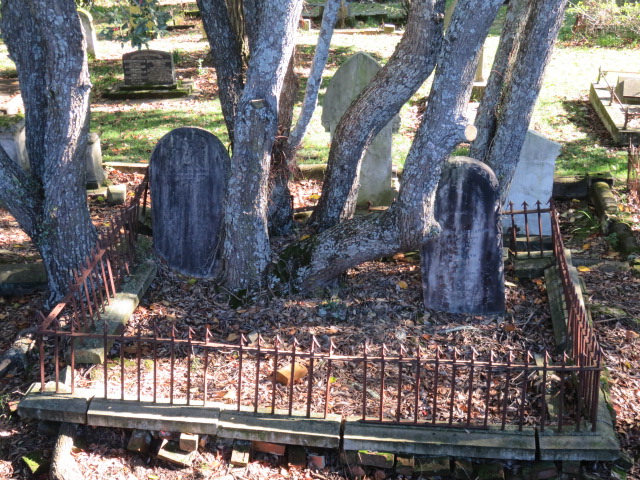I first heard about the Symonds Street Cemetery in Auckland when I read a murder mystery, checked out from our local library, that was written by a New Zealand author. In the story, a body had been discovered in the womens' restroom that is located at that cemetery. I enjoyed reading a novel that was set in 'my' city and that used real places to tell the story.
I then learned a little more about the cemetery when Allie once dropped me off at the corner of Symonds and Karangahape Roads. I noticed several of the Jewish grave stones as I walked past that part of the cemetery and began my exploration that day of the somewhat infamous K' Road. It was a fine Road to walk down and explore at 11 a.m. I mentioned in a past post though that it would probably not be the sort of place I'd feel comfortable waking down at 11 p.m.
I then learned a little more about the cemetery when Allie once dropped me off at the corner of Symonds and Karangahape Roads. I noticed several of the Jewish grave stones as I walked past that part of the cemetery and began my exploration that day of the somewhat infamous K' Road. It was a fine Road to walk down and explore at 11 a.m. I mentioned in a past post though that it would probably not be the sort of place I'd feel comfortable waking down at 11 p.m.
Well, time has passed and I thought I should do a little more research into this cemetery. It was Auckland's first cemetery after all. It opened in 1842 and was closed for burials in 1886.
Today I'm going to share some pictures and a bit of it's history with you. It has been rather negatively impacted by the growth of Auckland.
Today, it's definitely 'rough around the edges'. From what I've seen, upkeep appears to be spotty at best. And, from what I've read, the homeless tend to congregate for shelter at night under the Grafton Bridge, which has intruded into one side of the cemetery.
The date on this marker says 1934. I don't know why that is if the cemetery was closed to burials in 1886.
That's part of the Grafton Bridge, built back in 1910.
As you can see, it was built over and around many, many graves. Some remains were removed during it's construction. It sounds though, that many of these were not treated with due reverence.
The Catholic portion of the cemetery once extended up toward St. Benedict's Church that you see on the hill. When this, the Southern Motorway, was constructed in the mid 1960's, 4,100 more bodies were removed and re-interred in two memorial sites in the cemetery. I think that these remains were handled in a more appropriate manner.
This is a better picture of St. Benedict's. Yes, this is the church that we attended for a while after coming here. This is the 2nd St. Benedict's on this site. The first was a wooden church, blessed and opened in 1882. At the time, it was the largest wooden church in New Zealand and could seat 1,200. Unfortunately, it burned down in 1886 when a house near it caught fire and the fire spread. This church opened in 1888. The first chuch's picture is below.
This is one of the memorials to those people whose graves had to be moved in the 1960's.
And this is the other.
In the who-dunnit I read, the body was found in this building.
This is an example of the municipal architecture of the time. The combination of the bricks and large blocks was supposed to suggest permanence. Well, this building is still in partial use, 107 years after it was built, so I guess it's not doing so badly.
There is a homeless person sleeping in the alcove. You can see his blankets, etc.

Here is an early shot of the toilet/tram waiting rooms. Unsure of the date.
I'll end today with the view down K' Road. This was taken just a block away from the Jewish part of the cemetery.
K' Road doesn't look very 'boisterous' now does it? Well, even the rowdiest crowd needs their eight hours and they must be getting it now as I pass by. That's good.
K' Road doesn't look very 'boisterous' now does it? Well, even the rowdiest crowd needs their eight hours and they must be getting it now as I pass by. That's good.
I should probably take another walk along K' Road one of these days and take some pictures for a future post. It does have some very interesting buildings along it. -djf
















This is a fascinating history about the Symonds Street cemetery. It's odd to see gravestones next to city infrastructure - but probably no more unusual than the trees that have grown over some of the graves as well.
ReplyDeleteI really like the picture of the Grafton street bridge with Rangitoto in the background. From that view, you'd never guess it was built over a cemetery.
I also enjoyed your story about the history of St. Benedict's. Is it still capable of holding 1,200 people? The tower in the picture of the original church is very similar to that of St. Mary's Cathedral right here in downtown Lansing - must have been a common architectural design back then.
As always, thanks for sharing your research and adventures!
I am still puzzled by the 1934 date when the cemetery closed for burials in 1886. This is definitely a mystery. I love exploring old cemeteries. Each one is so unique. Thanks for an interesting post. McKenzie
ReplyDeleteIf you had a pre-purchased family plot, you could still be buried there (as the space was reserved) after the public closure in 1886. The last burial in a pre-purchased plot was in the 1950s.
DeleteThank you for this information. That makes sense of course.
Delete